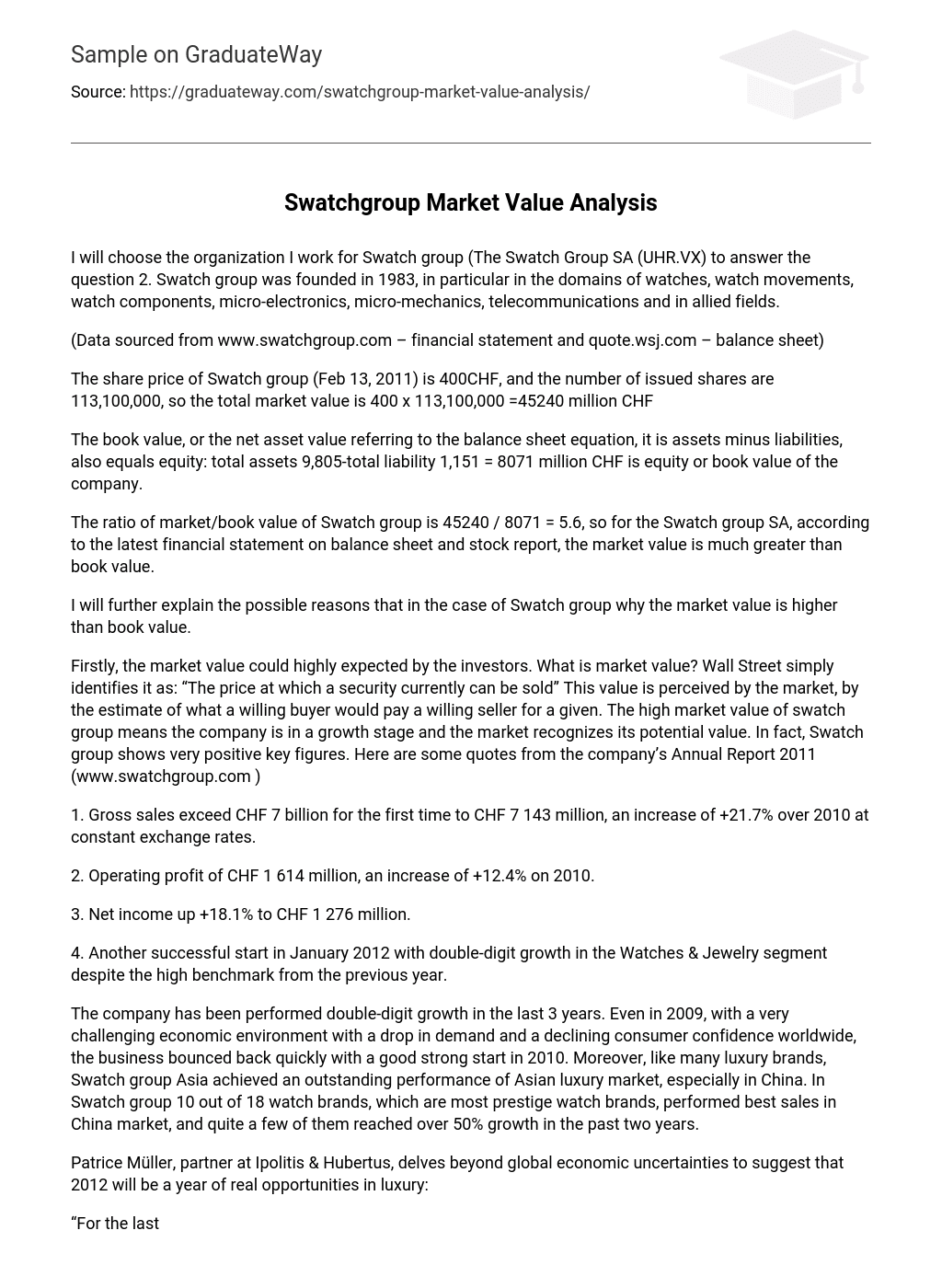I will choose the organization I work for Swatch group (The Swatch Group SA (UHR.VX) to answer the question 2. Swatch group was founded in 1983, in particular in the domains of watches, watch movements, watch components, micro-electronics, micro-mechanics, telecommunications and in allied fields.
Firstly, the market value could highly expected by the investors. What is market value? Wall Street simply identifies it as: “The price at which a security currently can be sold” This value is perceived by the market, by the estimate of what a willing buyer would pay a willing seller for a given. The high market value of swatch group means the company is in a growth stage and the market recognizes its potential value. In fact, Swatch group shows very positive key figures. Here are some quotes from the company’s Annual Report 2011 (www.swatchgroup.com )
- Gross sales exceed CHF 7 billion for the first time to CHF 7 143 million, an increase of +21.7% over 2010 at constant exchange rates.
- Operating profit of CHF 1 614 million, an increase of +12.4% on 2010.
- Net income up +18.1% to CHF 1 276 million.
- Another successful start in January 2012 with double-digit growth in the Watches & Jewelry segment despite the high benchmark from the previous year.
The company has been performed double-digit growth in the last 3 years. Even in 2009, with a very challenging economic environment with a drop in demand and a declining consumer confidence worldwide, the business bounced back quickly with a good strong start in 2010. Moreover, like many luxury brands, Swatch group Asia achieved an outstanding performance of Asian luxury market, especially in China. In Swatch group 10 out of 18 watch brands, which are most prestige watch brands, performed best sales in China market, and quite a few of them reached over 50% growth in the past two years.
Patrice Müller, partner at Ipolitis & Hubertus, delves beyond global economic uncertainties to suggest that 2012 will be a year of real opportunities in luxury:
“For the last two, three, even five to eight years, Asia has developed at very high percentages of growth but people are starting to believe this will be reduced. Not necessarily much – Asia is still likely to grow in 2012.” (luxurysociety.com).
Doherty from Bloomberg also asserted “Swatch is tapping growth in the Greater China region, where rising incomes are fueling demand for luxury goods. Swiss watch exports climbed 19 percent last year to a record 19.3 billion francs, with consumers in Asia accounting for more than half of the timepieces sold, while China became the third-biggest destination for watch exports.” (Bloomberg.com by Dermot Doherty Feb 7 Swatch 2011 Profit Advances 18% as Chinese Buy Omega Watches)
The continued and potential growth of business performance is certainly the most encouraging news to the investors, which leads to the high expectation and optimism to its stock share value. Secondly, there are some reasons leading to the relatively low book value. The intangible assets are a major reason: patent, R&D know-how technology and professional industry intelligence. The mechanics and manufactory of nowadays luxury timepieces are as advanced as any hi-tech intelligent companies. Taking OMEGA brand as an example, its well-known photo-finish timing camera known as “magic eye” executed time record for Olympic game over 50 years, redefined the art and science of world-class sports timing. Its latest new products series carries two patents: a unique diamond cutting craft and new metal material for scratch resistant blending of ceramic and alloy.
In fact, to assure and preserve the unique skill of traditional manufactory of timepieces and peruse the renovation of new technology of watch making, Swatch Group started offering their first class for aspiring watchmakers in September 2005 in 5 countries, which takes huge financial commitment but not recorded on the balance sheet same the way as property or inventory. Assets like this, which takes large amount of investment on R&D, yet with intangible outputs, are certainly not counted as asserts.
There is other intangible value: brand equity. Top brands like Apple, the brand value is 83mil USD determined by BrandZ index, while Swatch group’s 19 watch brands including some of the most-welcomed names: Swatch, OMEGA, Tissot…are surely valuable brand equity to the company.
There is another reason in terms of tangible assets come to my attention. The industry Swatch group operates is timepiece manufactory, includes one of the most archaic watch brands once only supplied to royal families hundreds years ago, like Breguet and Jaquet Droz. The present value of the assets of these brand business, specially its vintage collection products holds increasing value from time to time. For example, the recent auction for Breguet No 4244, the very 1st world’s perpetual calendar watch manufactured in 1934 with retail price CHF 11,000 then, sold for CHF 220,000 in Geneva 2010. Though these vintage luxury pieces collected and displayed by company museums and shops may not be counted as inventory, or may be only recorded as the retail price for the present asset value, their future and potential value could be significant.
There could be many other reasons caused for the difference between market and book value: the over-estimated market value for the luxury and timepiece market, after all people tend to rely on mobile and PC for timing in modern world. And other assets increased value than its cost value over years, like some precious rare metal, which are main resource for watch & jewelry parts manufactory.
However, though overshadowed by the weak European economic melt-down, I still expect the market value of Swatch group will continue growing excessive to its book value, thanks to the strong and powerful Asian markets.





